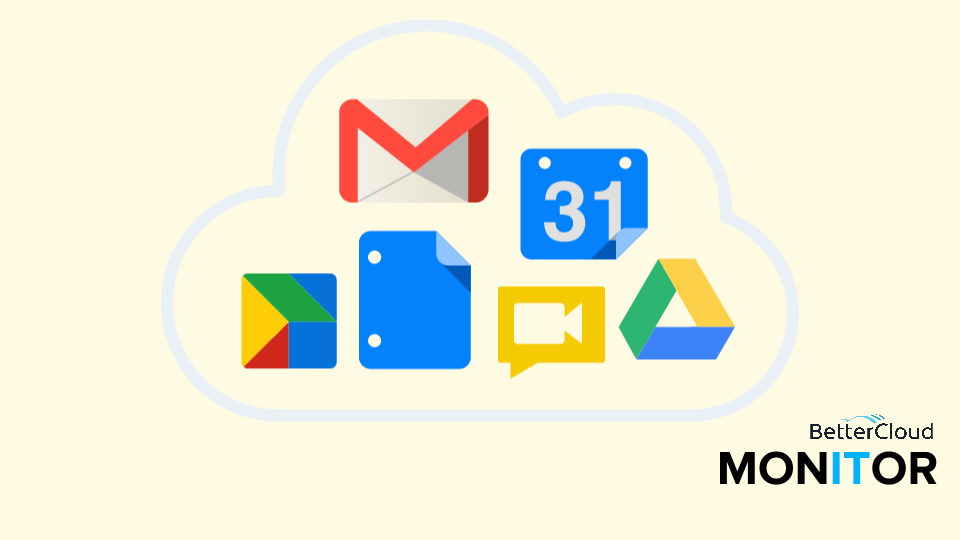Google Apps: The Numbers You Need to Know
November 13, 2012
9 minute read

When we started BetterCloud we made it company policy to stay in touch with our customers. As a part of this relationship, we recently surveyed our customers to find out more about their use of FlashPanel, our Google Apps security and management tool. Based on the data we collected, we’ve already implemented the top two requested features and have plans to make a number of additional improvements.The remaining survey data, which follows below, revealed some valuable information about Google Apps and the cloud ecosystem as a whole. It’s amazing what you can learn from your customers if you just take the time to ask.
Two weeks ago, we sent out a survey to our entire customer base of more than 10,000 Google Apps domains. With customers ranging from small nonprofits to large organizations with over 100,000 seats, the 1,300 responses we received covered the entire spectrum of the Google Apps customer base. In the process we gained valuable insight into Google Apps adoption and the overall outlook on cloud-based IT strategies.
After collecting the data, we broke responses into three segments: small businesses (fewer than 20 employees), mid-sized businesses (20-500 employees) and enterprises (500+ employees). We defined these business segments based on clear differences in the formal role played by IT decision makers, which we will discuss in further detail later in this post.
When we started compiling the results, we realized that we had uncovered and confirmed some really interesting information, and based on the fact that there is almost no data like this available publicly, we thought it would be best to put it together and share it with you here. The following data reveals huge opportunities in this space and is aimed to help the Google Apps ecosystem – resellers, partners and ISVs and of course, the organizations who have gone Google.
Account Size
 Majority of all seats are represented by a minority of domains: Time and time again, Google refers to the number of businesses (now 5 million) using Google Apps, but rarely focuses on the number of users within these businesses. Our data shows that a majority of our users come from a relatively small number of domains. Clearly, it makes sense to focus considerable effort on all business segments, including the enterprise.
Majority of all seats are represented by a minority of domains: Time and time again, Google refers to the number of businesses (now 5 million) using Google Apps, but rarely focuses on the number of users within these businesses. Our data shows that a majority of our users come from a relatively small number of domains. Clearly, it makes sense to focus considerable effort on all business segments, including the enterprise.
Industry Breakdown

 Highly regulated industries reluctant to adopt Google Apps: Based on our findings, it’s evident that the most regulated industries like financial services and energy, are not making the move to Google at the same speed as others. Traditionally, these industries require a high level of data security, which can be blamed for their reluctance to migrate to the cloud. But recently, we’ve seen a number of security focused ISVs introduce products specifically aimed to help these highly regulated industries make the move more comfortable (precisely why we continue to Gmail and Google Drive security features to FlashPanel). We think there is a similar opportunity for resellers to focus on some of these industries. Yes, these customers will probably require more bandwidth from you and your team, but in return they are willing to invest abundant time and capital in order to operate in environments tailored to their needs.
Highly regulated industries reluctant to adopt Google Apps: Based on our findings, it’s evident that the most regulated industries like financial services and energy, are not making the move to Google at the same speed as others. Traditionally, these industries require a high level of data security, which can be blamed for their reluctance to migrate to the cloud. But recently, we’ve seen a number of security focused ISVs introduce products specifically aimed to help these highly regulated industries make the move more comfortable (precisely why we continue to Gmail and Google Drive security features to FlashPanel). We think there is a similar opportunity for resellers to focus on some of these industries. Yes, these customers will probably require more bandwidth from you and your team, but in return they are willing to invest abundant time and capital in order to operate in environments tailored to their needs.
You could argue that the industries most reluctant to migrate to the cloud actually stand to gain the most from such a migration. Decades old computing policies have compounded the inefficiencies of many of these antiquated industries and migrations to 21st century systems could usher in huge change – just think of the gains to be made with broad adoption of cloud-based EHRs in healthcare.
One thing you hear a lot in Google’s sales pitch is, “you think you are really better at securing your data than we are? Look at our purpose-built data centers protected by armed guards, redundancy, sharding processes, backup tapes and more.” Highly regulated industries will realize Google possesses economies of scale and security expertise that just cannot be replicated by individual businesses.
Role Across Organization Size
Question: What title best defines your role/responsibilities?

Role varies across segments: The overall role played by an organization’s Google Apps manager varies quite a bit depending on company size. As you look at larger organizations, you see more specialized roles and you are more likely to see technical employees interacting with Google Apps and related software on a daily basis. In fact, several of our customers have a dedicated “Google Apps Administrator” on staff. This specialization proves the depth of the Google Apps suite and that the platform is a truly powerful and comparable replacement for on-premise systems.
Key takeaways for selling to Google Apps customers:
- Google Apps managers in the enterprise are subject matter experts with technical backgrounds while the person managing Google Apps in organizations with fewer than 20 employees has an exceedingly broader role, and is most often the business owner.
- Owners, who are also buyers in this case, typically look for easy-to-use and highly integrated solutions without steep learning curves. After all, small business owners are likely wearing several hats and need to spend less time managing IT.
- Enterprise buyers look for robust, scalable and dependable solutions, sometimes even choosing to build their own software to fill a niche specific to their organization.
Email System
Question: What email system did your company use prior to migrating to Google Apps?
 Exchange prevails across the board, but a high percentage of enterprises migrate from Lotus Notes: Prior to “going Google,” Microsoft Exchange was the clear winner across all business segments (no surprise here). However, nearly one quarter of all small businesses have been on Google Apps since their founding, pointing to early adoption of cloud-based messaging systems among smaller organizations. For new businesses, there is little if any argument for choosing an on-premise mail system over a cloud-based product. And though small businesses are already “sold” on Google Apps, a huge opportunity for resellers remains, especially as Google rolls out more products. (*See “Google Apps Resellers” below).
Exchange prevails across the board, but a high percentage of enterprises migrate from Lotus Notes: Prior to “going Google,” Microsoft Exchange was the clear winner across all business segments (no surprise here). However, nearly one quarter of all small businesses have been on Google Apps since their founding, pointing to early adoption of cloud-based messaging systems among smaller organizations. For new businesses, there is little if any argument for choosing an on-premise mail system over a cloud-based product. And though small businesses are already “sold” on Google Apps, a huge opportunity for resellers remains, especially as Google rolls out more products. (*See “Google Apps Resellers” below).
Key takeaways for Google Apps resellers:
- For Google Apps resellers aiming to win more of those elusive enterprise deals, we believe that it is vital to have some resources that are focused on or are experts in Lotus Notes, which can be one of the more difficult migrations to conduct.
- When a company leaves Lotus Notes, they usually migrate mail, calendar and contacts but many times they leave their Domino server running with their custom applications. There are huge opportunities here for resellers to rebuild those specific applications in the cloud, or to introduce the customer to Google Apps Marketplace solutions that can replace their Domino applications.
Microsoft Office 365 usage may not be interesting today, but in another five to ten years when the platform reaches critical mass, it could be a serious competitor to Google Apps. Accelerating this competition will lead to extremely low barriers to switching, facilitated by out-of-the-box cloud to cloud migration products already on the market. It is going to get very interesting once companies can “easily” switch.
Salesforce.com and Google Apps Overlap
Question: What CRM does your company use?
 Significant overlap between Google Apps and Salesforce.com: As far as we know, this is the first concrete data revealing any overlap between Google Apps and Salesforce.com, though such an overlap has been highly speculated.
Significant overlap between Google Apps and Salesforce.com: As far as we know, this is the first concrete data revealing any overlap between Google Apps and Salesforce.com, though such an overlap has been highly speculated.
Key takeaways:
- As adoption of both Google Apps and Salesforce.com increases over time, the overlap between them will grow substantially.
- Based on this information and customer feedback in Salesforce.com’s Idea Exchange, which puts a Google Apps/SFDC integration third on the list of most requested features, you should expect to see both ISVs and resellers taking advantage of opportunities to integrate these two systems in the coming years.
Other data collected regarding CRM usage reveals an extremely fragmented environment trailing Salesforce.com, both in the cloud, where lightweight CRMs prevail, and on-premise.
**Note: We also asked survey recipients which ticketing system they use and the number one response was Zendesk at 6.2% overall with a large number of respondents citing they actually use email for ticketing.
Perspective on the Cloud
Question: Has your company made a decision to move all of your applications and infrastructure to the cloud?
 Enterprises uncomfortable migrating entirely to cloud: According to data released by the Cloud Alliance for Google Apps, large organizations (200 or more employees) were most concerned with security and privacy risks prior to migrating to Google Apps. These concerns likely carry over to other cloud-based systems, shedding light on why large organizations are uncomfortable with moving their entire IT infrastructure to the cloud.
Enterprises uncomfortable migrating entirely to cloud: According to data released by the Cloud Alliance for Google Apps, large organizations (200 or more employees) were most concerned with security and privacy risks prior to migrating to Google Apps. These concerns likely carry over to other cloud-based systems, shedding light on why large organizations are uncomfortable with moving their entire IT infrastructure to the cloud.
Key takeaways:
- With a majority of enterprise-sized organizations reluctant to move entirely to the cloud and over half of mid-sized businesses not yet willing to do so, there appears to be a huge opportunity for cloud service providers. We’ve not yet reached the tipping point, but presumably as time goes on and systems become more advanced and cost-effective, more and more businesses will be willing and ready to move entirely to the cloud.
- We believe the power, flexibility and accessibility associated with cloud computing is often times holding organizations back. Many companies fear giving up the type of control they have with on-premise environments. However, surrounding these major cloud platforms is a growing industry of Cloud Management and Security tools that provide the added security and control companies desire.
- It looks like messaging is the “first frontier” when it comes to cloud adoption, but as time goes on organizations will seek to create entirely cloud-based infrastructures and migrate other on-premise systems to the cloud.
For those currently in the Google Apps ecosystem, we’re just at the beginning of the adoption curve. You may be fighting an uphill battle now, but at a certain point it will almost be a necessity to migrate to the cloud. We will reach this point, it is just a matter of when. Outgrowing existing systems and changing age-old business processes certainly takes time, but you’re at the forefront of an emerging industry and you have the opportunity to take advantage of your early expertise in this space.
Google Apps Resellers
Question: Did you purchase Google Apps licenses through a reseller?
 Enterprises rely highly on resellers’ expertise when migrating to Google Apps: Based on our findings, and in line with BetterCloud’s beliefs, organizations with more than 500 users need the assistance of a Google Apps reseller for both technical assistance and user training.
Enterprises rely highly on resellers’ expertise when migrating to Google Apps: Based on our findings, and in line with BetterCloud’s beliefs, organizations with more than 500 users need the assistance of a Google Apps reseller for both technical assistance and user training.
Key takeaways:
- For mid-sized businesses, the choice of whether or not to use a reseller usually depends on the complexity of the migration, amount of data to migrate, your IT team’s technical experience and available resources, and last but not least your employees’ familiarity with Gmail and other Google products (we wholeheartedly believe that most companies do not spend enough money during the migration process on training and change management).
- For small businesses, where less than 20% go through a reseller, it is often easiest to contact Google directly and purchases Apps licenses online. However, Google is continuing to build out its business offerings and even the smallest organizations will likely require some assistance. Perhaps the ecosystem has not evolved enough to fully understand this need, but when small businesses adopt Chromebooks or implement Android-based mobile device policies, the value of a reseller will be quickly realized.
Conclusion
We started this company and chose to focus on Google Apps management and security because of the genuine passion our team has for this space. We truly believe in what Google is doing and have seen how Google Apps can change a business and provide an organization with the ability to scale and collaborate at all levels, something most hadn’t even imagined. There is a great sense of community around the companies that have built businesses to support this ecosystem, whether it be resellers or ISVs like us. We have a lot of work to do, but at this point, you can’t argue with the fact that companies of all sizes will continue to increase their adoption of cloud platforms, applications and infrastructure.
The data we’ve collected from our amazing customers shows that we’re just at the beginning of this adoption curve and there couldn’t be a more exciting time to be a part of the Google Apps ecosystem. We look forward to seeing how Google Apps and our customers evolve and encourage everyone in this space to take this information to heart.
We’re excited to see shifts in this space in 2013, when we conduct our next survey.
*This post was created using Docs, Sheets and Chromebooks exclusively.
This post has been revised to reflect the following correction:
Correction: November 15, 2012
Our comments in the “Account Size” section have been updated to reflect only our user base and not the account size of all Google Apps domains.
For more Google Apps news and insights, subscribe to the BetterCloud blog.






